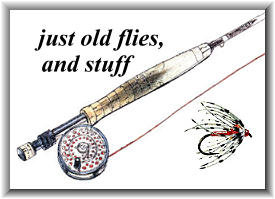It is believed that this pattern was original with, and
named after, Major John P. Traherne, of England, author
of a chapter on salmon fishing in Pennell's book,
Salmon & Trout.
The Captain, Champion, Red Jay, Claret Jay and Dirty Orange
are also the Major's patterns.
There is another claim that this fly was named after Major W.D.
Turle, of Newton Stacey, England. He died in 1909. He was a
pioneer of dry fly fishing and first practiced at Winchester
where it originated. He was the originator of the Turle knot,
sometimes incorrectly spoken of as the turtle knot. He retired
from the British Army after serving in the Indian Mutiny,
1857-8. Being wounded at the Seige of Delhi.
Major
As tied by Ray Bergman
Head: Black.
Tag: Blue floss; gold tinsel tip.
Tail: Golden pheasant tippet.
Body: Purple wool.
Rib: Gold tinsel.
Hackle: Scarlet palmer, blue at shoulder.
Wing: Brown turkey, gray mallard.
Credits:
Information from Fly Patterns and Their Origins by Harold
Hinsdill Smedley. Photo from Forgotten Flies by Paul
Schmookler and Ingrid V. Sils.
|



